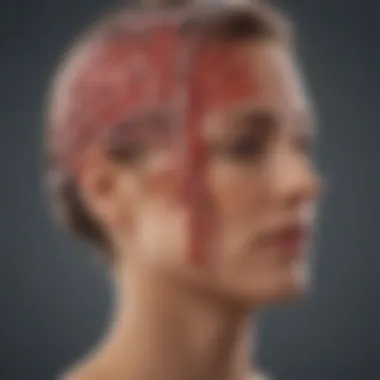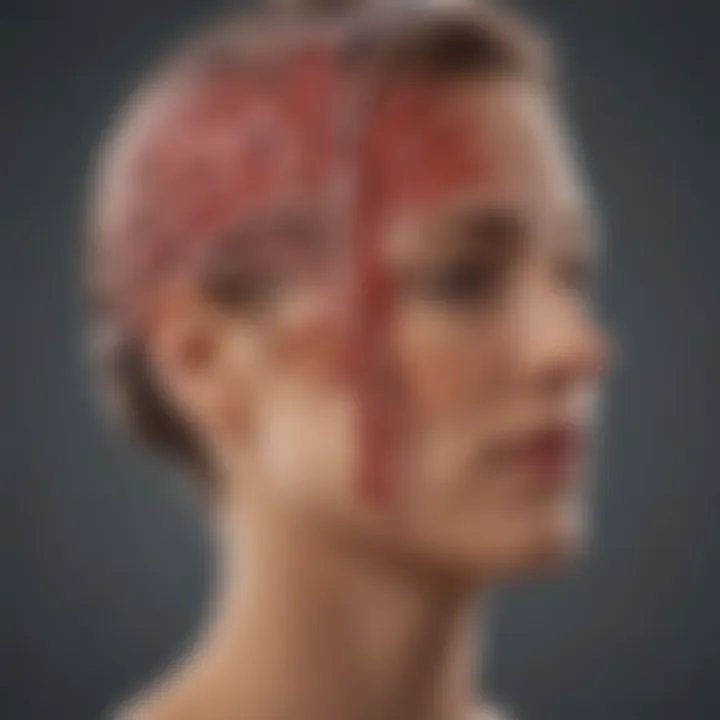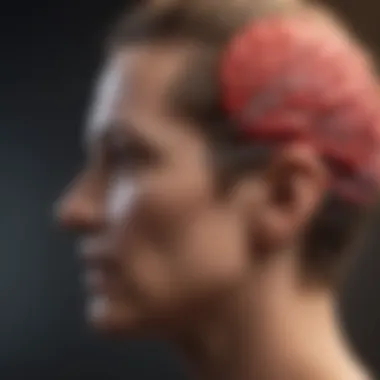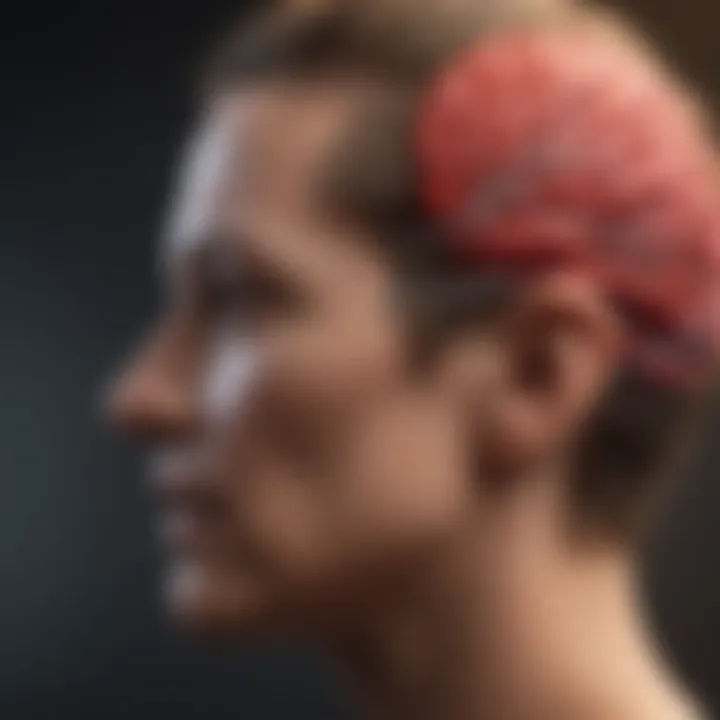Understanding Stroke: A Cardiovascular Perspective


Intro
Stroke represents a significant public health concern that intersects with the broader category of cardiovascular diseases. It is essential to understand stroke not only as a standalone condition but also as a critical manifestation of cardiovascular health. This exploration brings to light the classifications, mechanisms, and implications associated with strokes, supporting a deeper comprehension of their role within cardiovascular disease.
Research indicates that strokes are largely categorized into two primary types: ischemic and hemorrhagic. Each category encapsulates distinct mechanisms and risk factors that enhance the risk of occurrence. This understanding is crucial for students, researchers, educators, and professionals working in health sectors because it directs attention to prevention strategies and to the importance of informed public health initiatives.
This article aims to demystify the complexities surrounding strokes. By systematically breaking down the topic, readers will gain insight into the intricate relationship between stroke and cardiovascular health, helping to clarify common misconceptions that exist within public discourse.
Research Overview
Summary of Key Findings
The examination of strokes within the cardiovascular framework reveals several key takeaways:
- Classification: Strokes are primarily classified into ischemic and hemorrhagic, with ischemic strokes constituting approximately 87% of all cases.
- Mechanisms: Underlying the classification are various biological mechanisms, including blood clots and vessel ruptures that define the occurrence of either type of stroke.
- Risk Factors: Identifying specific risk factors such as hypertension, diabetes, and lifestyle choices is essential for stroke prevention and intervention strategies.
- Implications for Public Health: Understanding the public health implications leads to informed resource allocation and tailored strategies aimed at reducing the incidence of strokes in populations.
Importance of the Research
The importance of this research cannot be overstated. With strokes being one of the leading causes of death and disability worldwide, recognition of their classification as a cardiovascular disease elevates the urgency for public awareness. The findings illuminate the significant intersections between various health conditions and stroke, offering valuable insights for improving community health initiatives. Both healthcare providers and stakeholders within the public health domain can benefit from this enhanced understanding, which emphasizes prevention and education as paramount.
Methodology
Study Design
This exploration adopts a comprehensive review design, synthesizing data from past research to highlight the mechanisms, risk factors, and implications of stroke. It draws from a variety of sources including clinical studies, public health reports, and meta-analyses.
Data Collection Techniques
Data is collected through systematic reviews and meta-analyses of existing literature concerning stroke pathology and epidemiology. Analytical techniques utilized include:
- Peer-reviewed journals
- Health organization reports
- National databases on stroke incidences
This structured methodology ensures a robust examination of strokes within the cardiovascular context, providing a credible basis for the conclusions drawn.
"Understanding stroke as a cardiovascular disease not only enhances awareness but significantly impacts prevention and treatment approaches across diverse populations."
This detailed analysis serves as a guide to understanding strokes comprehensively, addressing both their medical implications and societal significance.
Preamble to Stroke and Cardiovascular Disease
Understanding the nuances of stroke within the context of cardiovascular disease is vital for comprehending its broader implications on health. Stroke, a potent medical condition, not only signifies a serious health crisis for individuals but also poses a significant public health threat. The relationship between stroke and cardiovascular disease is multifaceted, revealing insights into prevention, treatment, and rehabilitation strategies.
The prevalence of cardiovascular diseases is alarming, with stroke accounting for a large portion of mortality rates globally. This article will delve into definitions, mechanisms, risk factors, and the long-term effects of stroke. It is crucial for students, researchers, educators, and healthcare professionals to equip themselves with this knowledge to foster effective strategies for patient education and disease prevention.
Defining Cardiovascular Disease
Cardiovascular disease encompasses a range of disorders affecting the heart and blood vessels. These conditions can lead to severe complications, including heart attacks and strokes. A stroke is classified as an acute cerebrovascular accident, highlighted by a sudden loss of brain function due to an interruption in the blood supply. Its classification under the cardiovascular umbrella underscores the interconnectedness of all cardiovascular diseases.
The common types include:
- Coronary Artery Disease
- Hypertension
- Peripheral Artery Disease
- Stroke
Understanding these categories is crucial, as it helps identify high-risk populations and formulate targeted interventions.
Overview of Stroke
Stroke is a critical event that occurs when the blood flow to a part of the brain is disrupted. This deprivation of oxygen and nutrients leads to cell death, resulting in loss of function. There are primarily two types of strokes: ischemic and hemorrhagic. Each type has unique etiologies, risk profiles, and management strategies.
According to the World Health Organization, stroke is a leading cause of disability worldwide. The resultant impairments can affect physical, cognitive, and emotional well-being, necessitating comprehensive healthcare approaches post-event.
"Awareness and understanding of stroke can significantly reduce mortality and long-term disability."
In summary, stroke is a complex and multifactorial condition that serves as a significant indicator of cardiovascular health. The pathways leading to stroke are intertwined with cardiovascular disease, emphasizing the importance of recognizing risk factors and preventive measures.
Types of Stroke
Understanding the types of stroke is essential when examining stroke as a cardiovascular disease. Each type of stroke has distinct mechanisms and risk factors that influence patient outcomes. Recognizing these differences allows for better diagnosis, treatment, and prevention strategies. This knowledge is vital for healthcare professionals, researchers, and students who aim to grasp the complexity of stroke pathology.


Ischemic Stroke
Ischemic stroke accounts for approximately 87% of all strokes. This type occurs when a blood vessel supplying blood to the brain is obstructed. The blockage may arise due to a blood clot formed in the arteries leading to the brain, known as a thrombotic stroke, or from a clot that travels from another part of the body, termed an embolic stroke.
Several factors contribute to the risk of ischemic stroke:
- Atherosclerosis: The buildup of fatty deposits in arteries narrows the vessels, increasing the risk of clots.
- Atrial fibrillation: This heart condition can lead to the formation of blood clots in the heart, which can then travel to the brain.
- High blood pressure: Elevated levels can damage arteries over time, raising the probability of clots.
The consequences of an ischemic stroke depend on the duration of the blockage and the area of the brain affected. Common symptoms may include sudden numbness or weakness, especially on one side of the body, confusion, and difficulty speaking or understanding speech.
Hemorrhagic Stroke
Hemorrhagic stroke, while less common, poses significant health risks. It occurs when a blood vessel in the brain ruptures, causing bleeding within or around the brain. This type of stroke can result in increased intracranial pressure and subsequent damage to brain tissues.
Key causes of hemorrhagic stroke include:
- Aneurysms: Weak areas in blood vessel walls may balloon and burst, leading to significant bleeding.
- Arteriovenous malformations (AVMs): These are abnormal tangles of blood vessels that can rupture.
- Severe hypertension: Chronic high blood pressure can weaken blood vessel linings, making them prone to rupture.
Symptoms often mirror those of ischemic strokes but can also include a sudden, severe headache and nausea. It is crucial to recognize these signs promptly, as rapid medical intervention can mitigate damage and improve outcomes.
Transient Ischemic Attack (TIA)
A transient ischemic attack, commonly known as a TIA or mini-stroke, is a temporary episode of symptoms similar to those of a stroke. TIAs last for a few minutes to a few hours and do not cause permanent damage.
They serve as critical warning signs for potential future strokes. Understanding TIA is important because:
- Risk Factor: TIAs indicate a higher risk for full-blown strokes in the future.
- Preventive Action: Identifying TIA can lead to interventions to modify risk factors, like lifestyle changes or medication adjustments.
Although symptoms may resolve within 24 hours, it is vital to seek medical attention immediately. Recognizing TIA can be life-saving, highlighting the need for public awareness and education regarding the warning signs of stroke.
Pathophysiology of Stroke
The pathophysiology of stroke is a crucial area of study within the broader context of cardiovascular diseases. Understanding the physiological mechanisms behind strokes provides insights into their prevention, diagnosis, and treatment. This section delves into the underlying causes, exploring ischemia for ischemic strokes and hemorrhagic causes for hemorrhagic strokes.
Mechanisms of Ischemia
Ischemic stroke occurs when blood flow to the brain is interrupted. This disruption leads to a cascade of cellular and molecular events. The primary mechanism is the obstruction of cerebral arteries, usually by a blood clot. Common causes include atherosclerosis and embolism.
Atherosclerosis involves the buildup of plaques within artery walls, narrowing the vessel and potentially leading to rupture. When an embolism occurs, a clot that forms elsewhere in the body travels to the brain, blocking blood supply.
Once ischemia happens, neurons in the affected area become deprived of essential nutrients and oxygen. Metabolic derangements result in cell death. The brain, being highly sensitive to oxygen deprivation, experiences significant damage within minutes. The term "penumbra" is often used to describe the area surrounding the core of damage, where cells are at risk but not yet dead.
Treatment for ischemic stroke focuses on restoring blood flow. Timely intervention can prevent extensive damage. In some cases, thrombolytics are administered to dissolve blood clots, while mechanical thrombectomy might be employed to remove the blockage.
Causes of Hemorrhage
Hemorrhagic stroke can occur when a blood vessel in the brain ruptures. This type involves two primary categories: intracerebral hemorrhage and subarachnoid hemorrhage. Each has distinct causes and implications.
Intracerebral hemorrhage often results from chronic conditions such as hypertension, which can weaken blood vessels over time. Other risk factors include trauma, arteriovenous malformations, and bleeding disorders. In contrast, subarachnoid hemorrhage usually stems from the rupture of an aneurysm, balloon-like expansions of blood vessels.
The immediate effect of hemorrhage is increased intracranial pressure. This can lead to reduced blood flow to surrounding areas, exacerbating the overall damage. Patients may exhibit symptoms such as sudden headaches, loss of consciousness, or neurological deficits. Management strategies may include controlling blood pressure, surgery to repair the ruptured vessel, or draining accumulated blood.
Understanding these mechanisms is essential for developing effective preventative strategies and treatment modalities for stroke.
Risk Factors for Stroke
Understanding the risk factors for stroke is crucial as it informs prevention strategies and promotes awareness. Identifying these factors enables both individuals and healthcare professionals to tailor interventions that can significantly reduce stroke incidence. Recognizing how both lifestyle choices and genetic predispositions contribute to stroke risk offers valuable insight into enhancing cardiovascular health.
Modifiable Risk Factors
Modifiable risk factors are those that individuals can change through lifestyle choices and medical interventions. They play an essential role in stroke prevention. Some of the prominent modifiable risk factors include:
- Hypertension (High Blood Pressure): This is one of the primary risk factors for stroke. Uncontrolled hypertension can lead to damage in blood vessels, increasing the likelihood of ischemic and hemorrhagic strokes.
- Diabetes: Individuals with diabetes have higher blood sugar levels, which can damage blood vessels over time. Effective control of blood sugar can diminish this risk.
- High Cholesterol: Elevated cholesterol levels can lead to arteriosclerosis, making arteries more prone to blockage. A balanced diet and exercise can help manage cholesterol levels effectively.
- Smoking: Tobacco use has been definitively linked to a higher risk of stroke. Smoking contributes to the formation of clots and increases blood pressure. Quitting smoking can significantly reduce stroke risk.
- Physical Inactivity: Sedentary lifestyles lead to obesity and high blood pressure. Regular exercise is an effective strategy in combating these risk factors.
- Heavy Alcohol Consumption: While moderate drinking may have some protective effect, excessive alcohol intake increases the risk of stroke due to its impact on blood pressure and heart health.
Taking steps to modify these risk factors can greatly reduce the overall risk of stroke, thereby enhancing one’s quality of life.
Non-Modifiable Risk Factors
Non-modifiable risk factors are those that individuals cannot change, such as genetics and age. While these factors cannot be altered, understanding their role is vital for assessing overall stroke risk. Key non-modifiable risk factors include:


- Age: The risk of stroke increases with age, particularly for individuals over 55. Aging contributes to vascular changes and the likelihood of developing comorbidities.
- Family History: A family history of stroke may increase an individual’s risk. Genetic predisposition plays a role, as certain conditions can run in families, such as hypertension or high cholesterol.
- Ethnic Background: Certain ethnicities may have a higher predisposition to stroke, influenced by genetic factors or socioeconomic status. For instance, African Americans face a greater risk due to higher rates of hypertension and diabetes.
- Gender: While stroke affects both men and women, studies suggest that women may have a higher lifetime risk. Hormonal factors and their effects on cardiovascular health are still being researched.
Recognizing non-modifiable risk factors contributes to a comprehensive strategy for stroke prevention. This understanding does not lead to despair but rather empowers individuals to focus on modifying the factors within their control and to seek appropriate medical care.
Understanding risk factors is key in preventing strokes and maintaining cardiovascular health. The interplay of modifiable and non-modifiable factors underscores the importance of a proactive approach.
Complications of Stroke
The complications of stroke are critical to discuss as they highlight the often devastating repercussions that accompany this condition. Understanding these complications helps in grasping the overall impact of strokes, both on individuals and society as a whole. This section will delve into long-term effects and the profound impact on quality of life that may ensue following a stroke.
Long-Term Effects
The long-term effects of stroke can be significant and varied. Individuals may experience a range of physical, cognitive, and emotional challenges post-stroke. Common physical difficulties include paralysis or weakness on one side of the body, which can severely restrict mobility and independence.
Cognitive difficulties often arise, such as problems with memory, attention, and processing speed. These changes can lead to difficulties in performing daily activities and engaging in social interactions. Emotional challenges like depression and anxiety are prevalent as well. Many stroke survivors face the reality of needing ongoing support and rehabilitation to navigate these changes.
Additionally, the risk of recurrent strokes increases significantly among survivors. This doubles the urgency for effective prevention strategies and regular medical follow-ups.
Impact on Quality of Life
The impact of stroke on quality of life can be profound and multidimensional. Survivors frequently report a significant decline in overall well-being, which can stem from physical limitations, cognitive impairments, and emotional challenges. A stroke can drastically alter life routines, leading to a loss of autonomy and independence.
Moreover, the social implications are considerable. Many individuals face challenges in maintaining relationships or returning to work. This not only affects their self-esteem but also creates a potential for isolation.
Impact on Quality of Life Factors:
- Social Life: Limited ability to engage in social activities can lead to loneliness.
- Employment: Many survivors struggle to return to their previous jobs or face unemployment.
- Physical Health: Ongoing health conditions may develop, complicating recovery.
"Stroke creates a ripple effect, influencing not only the survivor but those around them."
Addressing these complications requires a comprehensive approach that includes management of physical impairments and psychological support. Rehabilitation programs often focus not just on physical recovery but also on improving the overall quality of life. These include occupational therapy, counseling, and community support services.
Diagnosis of Stroke
The diagnosis of stroke is a critical component in the management of this serious health condition. Early and accurate diagnosis significantly influences treatment outcomes and can ultimately save lives. Understanding the various aspects involved in diagnosing stroke helps medical professionals act swiftly and efficiently. Moreover, recognizing stroke symptoms promptly can lead to timely intervention, which is vital since every minute counts during a stroke event. This section delves into the clinical assessment and imaging techniques utilized in diagnosing stroke effectively.
Clinical Assessment
Clinical assessment is the first step in diagnosing stroke. It involves a thorough evaluation of the patient’s medical history and physical examination. Medical professionals often use the FAST acronym to identify stroke symptoms:
- Face drooping
- Arm weakness
- Speech difficulties
- Time to call emergency services
These indicators are crucial in initiating the right response. During the assessment, a doctor will check for other signs such as altered consciousness, cognitive changes, and coordination issues. Vital signs, including blood pressure and heart rate, will also be measured.
The clinical assessment focuses on differentiating between ischemic and hemorrhagic strokes. Differentiating these types is crucial, as treatment varies. An ischemic stroke may necessitate thrombolytic therapy, while a hemorrhagic stroke may require surgical intervention. Therefore, thorough clinical assessment serves as a gateway to further diagnostic interventions, ensuring that the appropriate measures are taken quickly and accurately.
Imaging Techniques
Imaging techniques play an essential role in confirming the diagnosis of stroke and determining its type. Two primary imaging methods are commonly used:
- Computed Tomography (CT) Scan: This is typically the first imaging study ordered for someone suspected of having a stroke. A CT scan can quickly identify bleeding in the brain, which is important for diagnosing hemorrhagic strokes. It can also reveal areas of reduced blood flow for ischemic strokes, but may not always detect them immediately.
- Magnetic Resonance Imaging (MRI): An MRI is more sensitive than a CT scan in detecting ischemic strokes, especially in the early stages. The MRI provides detailed images of brain tissue, allowing physicians to visualize areas of damage and assess how the stroke may impact brain function.
Both imaging methods are pivotal to establishing a correct diagnosis. They can influence treatment decisions and provide insights into the extent of brain injury. In certain cases, additional imaging techniques, like angiography, may be necessary to visualize blood vessels and assess for blockages.
Proper and timely use of imaging techniques is essential in stroke management. Without precise diagnostics, treatment inefficiencies may arise, highlighting the need for trained professionals who can navigate these tools effectively.
The integration of clinical assessments and imaging techniques forms a coherent framework for diagnosing stroke. It underscores the importance of prompt evaluation and the utilization of advanced imaging technology to ensure accurate decision-making in stroke-related care.
Treatment Options for Stroke
The significance of treatment options for stroke cannot be understated. Effective treatment is crucial for minimizing damage to the brain, improving recovery outcomes, and enhancing the quality of life for survivors. The methods employed vary, depending on the type of stroke and the timing of medical intervention. This section highlights the primary strategies used in acute treatment, as well as the rehabilitation approaches following stabilization.
Acute Treatment Strategies
Acute treatment of stroke focuses on restoring blood flow to the brain or controlling bleeding. The initial minutes to hours following a stroke are known as the golden hours, during which appropriate interventions can save brain tissue and improve outcomes.
- Ischemic Stroke Treatments: For ischemic strokes, where a blood vessel is blocked, the standard treatment is thrombolysis. This involves administering tPA (tissue plasminogen activator), a medication that dissolves clots. Administering tPA within three to four and a half hours of symptom onset is shown to significantly reduce disability.
- Hemorrhagic Stroke Treatments: In cases of hemorrhagic stroke, the focus shifts to controlling the bleeding and reducing intracranial pressure. Options include:
- Mechanical thrombectomy is also an option for eligible patients. This procedure involves physically removing a blood clot using a catheter. Clinical trials show that it can improve outcomes for patients who present within 24 hours of the event.


- Surgical intervention: This may involve clipping the aneurysm or draining blood from the brain. Timely surgery can prevent further damage and stabilize the patient.
- Medications: Drugs may be given to manage blood pressure and prevent seizures, which are common after a hemorrhagic event.
Overall, prompt recognition and treatment of stroke are essential. Understanding the distinct treatment options available allows medical professionals to tailor care strategies for each patient.
Rehabilitation Approaches
After the acute treatment phase, rehabilitation is a key aspect of recovery from stroke. The aim is to help individuals regain as much function as possible and reintegrate into daily life. Rehabilitation can begin in the hospital and continues outpatient or at home depending on the needs of the patient.
- Physical Therapy: Physical therapists focus on improving coordination, strength, and mobility. This might involve exercises to enhance balance and gait, which are often affected after a stroke.
- Occupational Therapy: Occupational therapists assist patients with techniques for daily activities, like eating, dressing, and personal hygiene. This is crucial for restoring independence.
- Speech-Language Therapy: For those who experience difficulties with speech and language post-stroke, speech-language pathologists provide vital techniques and exercises to regain communication abilities.
- Counseling and Support Groups: Psychological support plays a significant role in recovery. Counseling can help with the emotional challenges following a stroke, and support groups enable survivors to share experiences and recovery tips.
Evidence suggests that comprehensive rehabilitation significantly enhances functional outcomes for stroke survivors.
In summation, tailored treatment strategies in the acute phase followed by intensive rehabilitation are essential for optimal stroke recovery. An informed understanding of these approaches can empower patients and families as they navigate the complexities of recovery.
Preventive Measures for Stroke
Preventive measures for stroke are crucial in reducing its incidence and minimizing its impact on individuals and society. Understanding these measures helps to mitigate the effects of strokes and promotes better cardiovascular health. By addressing stroke prevention, we can lower healthcare costs and improve the quality of life for those at risk.
Lifestyle Modifications
Adopting healthier lifestyle choices can significantly reduce the risk of stroke. Key aspects include:
- Healthy Diet: Emphasizing fruits, vegetables, whole grains, and lean proteins is essential. The Mediterranean diet is often suggested for its cardiovascular benefits.
- Regular Physical Activity: Engaging in at least 150 minutes of moderate exercise weekly helps maintain a healthy weight and reduce hypertension.
- Smoking Cessation: Quitting smoking benefits almost every aspect of health, particularly cardiovascular health. It significantly reduces the risk of both ischemic and hemorrhagic strokes.
- Alcohol Moderation: Limiting alcohol intake to moderate levels is vital. Excessive drinking can lead to hypertension and increase stroke risk.
These lifestyle changes lead to numerous benefits beyond stroke prevention. They enhance overall well-being, improve mental health, and contribute to longevity.
"Prevention is better than cure." - this mantra holds true in the context of stroke awareness and lifestyle modifications.
Public Health Initiatives
Public health initiatives play a vital role in preventing strokes on a large scale. These initiatives focus on raising awareness, facilitating access to healthcare, and encouraging community support. Important elements include:
- Awareness Campaigns: Programs that educate the public about stroke symptoms and risk factors can lead to earlier detection and treatment, reducing long-term damage.
- Screening Programs: Community health screenings can identify individuals at risk due to factors like high blood pressure or elevated cholesterol levels.
- Access to Resources: Ensuring communities have access to healthcare professionals, healthy foods, and recreational facilities supports healthier lifestyle choices.
- Policy Changes: Advocating for policies that support health education in schools and workplaces encourages a culture of wellness.
Effective public health initiatives not only inform individuals but also inspire collective action towards a healthier society. Such actions are fundamental in the fight against stroke and its related complications.
Stroke and Its Relationship to Cardiovascular Health
The relationship between stroke and cardiovascular health is fundamental in understanding how these two conditions interact and affect overall well-being. Stroke is recognized as a leading cause of death and disability worldwide, reflecting the significance of its connection to cardiovascular disease. As the heart and blood vessels play a crucial role in brain health, recognizing the implications of cardiovascular health can lead to more effective prevention and management strategies for both conditions.
Scientific Studies Linking Stroke to Cardiovascular Disease
Numerous studies have established a direct link between stroke and cardiovascular disease. The continuous risk factors that contribute to cardiovascular ailments, such as hypertension, diabetes, and hyperlipidemia, also exacerbate the risk of experiencing a stroke. For instance, a significant body of research published in the journal Stroke indicates that individuals with untreated high blood pressure are at a substantially increased risk of both ischemic and hemorrhagic strokes.
Research has also illustrated how cardiovascular events like myocardial infarction (heart attack) can precede a stroke. Such connections highlight the need for integrated care focusing on heart health to mitigate stroke risks. By employing various imaging techniques and assessment protocols, researchers have validated these correlations, enabling healthcare providers to design targeted interventions that can reduce the likelihood of stroke occurrence.
"Understanding the intricate relationship between cardiovascular health and stroke is essential for developing holistic treatment strategies."
Impact of Cardiovascular Health on Stroke Risk
The impact of cardiovascular health on the risk of stroke cannot be overstated. Poor cardiovascular health elevates the likelihood of stroke, suggesting that preventative measures should be directed towards maintaining optimal heart function. Factors such as obesity, sedentary lifestyle, and smoking create pathways to weakened cardiovascular health, increasing susceptibility to strokes. Those who prioritize cardiovascular fitness through regular exercise and balanced diets tend to have a lower incidence of both heart disease and stroke.
Several key considerations for individuals seeking to lower their stroke risk through cardiovascular health include:
- Regular Monitoring: Keeping track of blood pressure and cholesterol levels can help catch potential issues early.
- Diet and Nutrition: Emphasizing a diet rich in fruits, vegetables, whole grains, and healthy fats can bolster both cardiovascular and cerebral health.
- Physical Activity: Engaging in regular exercise strengthens the heart, enhances circulation, and reduces stress, all of which are protective against stroke.
The End
Addressing the topic of stroke within the context of cardiovascular disease is essential for multiple reasons. This article has highlighted the intricate relationship between stroke and cardiovascular health, emphasizing how understanding this relationship can lead to better prevention and treatment strategies. A clear grasp of stroke’s classification, mechanisms, and risk factors is crucial for both healthcare professionals and the general public.
The discussion around stroke goes beyond merely identifying its types. It involves recognizing the broader public health implications, understanding how to mitigate risk factors, and promoting awareness regarding signs and symptoms. In doing so, we can work toward reducing incidence rates and improving recovery outcomes for those affected.
Summary of Findings
In reviewing the findings presented throughout this article, several key points emerge:
- Definition and Impact: Stroke is classified as a major type of cardiovascular disease, underscoring its severity in the context of global health.
- Mechanisms and Risks: There are distinct mechanisms behind the various types of strokes, such as ischemic and hemorrhagic strokes, each with unique risk factors that can be modified.
- Complications and Quality of Life: The complications resulting from a stroke have a profound impact not only on individual health but also on quality of life, emphasizing the necessity for effective rehabilitation and support.
- Preventive Measures: Lifestyle modifications and public health initiatives are paramount in reducing stroke risk, showcasing the importance of proactive health management.
Future Directions for Research
Future research should focus on several critical areas to enhance understanding and management of stroke as a cardiovascular disease:
- Exploration of Genetic Factors: Investigating the genetic predisposition to stroke can provide insights into personalized treatment approaches.
- Advancements in Treatment: Ongoing studies on novel treatment strategies may yield more effective recovery methods and prevent long-term complications.
- Public Health Strategies: Evaluating the effectiveness of community health initiatives aimed at reducing stroke incidence could yield valuable data to shape future health policies.
- Technology Utilization: Incorporating technology, such as telemedicine and wearable devices, to monitor high-risk individuals for early detection of stroke symptoms or risk factor management.
Research in these areas will be beneficial in cultivating a comprehensive understanding of strokes and their classification within cardiovascular diseases. By prioritizing ongoing inquiry and adaptation in approaches, we can tackle the enormous burden that strokes impose on individuals and healthcare systems alike.



